
Mackerel is a common name applied to a number of different species of pelagic fish, mostly from the family Scombridae. They are found in both temperate and tropical seas, mostly living along the coast or offshore in the oceanic environment.
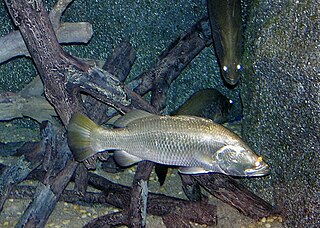
Lates is a genus of freshwater and euryhaline lates perches belonging to the family Latidae. The generic name is also used as a common name, lates, for many of the species.

Salvelinus is a genus of salmonid fish often called char or charr; some species are called "trout". Salvelinus is a member of the subfamily Salmoninae within the family Salmonidae. The genus has a northern circumpolar distribution, and most of its members are typically cold-water fish that primarily inhabit fresh waters. Many species also migrate to the sea.

The Priacanthidae, the bigeyes, are a family of 18 species of marine ray-finned fishes. "Catalufa" is an alternate common name for some members of the Priacanthidae. The etymology of the scientific name refers to the family's very rough, spined scales. The common name of "bigeye" refers to the member species' unusually large eyes, suited to their carnivorous and nocturnal lifestyles. Priacanthidae are typically colored bright red, but some have patterns in silver, dusky brown, or black. Most species reach a maximum total length of about 30 cm (12 in), although in a few species lengths of over 50 cm (20 in) are known.
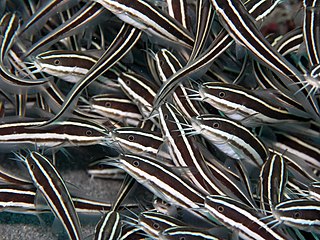
Plotosus is a genus of eeltail catfishes native to the Indian Ocean, the western Pacific Ocean and New Guinea.

Acanthurus japonicus, the Japan surgeonfish, white-faced surgeonfish, gold rim tang, powder brown tang and white-nose surgeonfish, is a species of marine ray-finned fish belonging to the family Acanthuridae, the surgeonfishes, unicornfishes or tangs. This fish is found in the Western Pacific Ocean.

An anchovy is a small, common forage fish of the family Engraulidae. Most species are found in marine waters, but several will enter brackish water, and some in South America are restricted to fresh water.
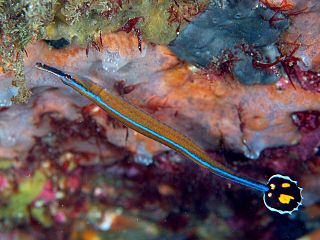
Doryrhamphus is a genus of pipefishes, one of the two genera colloquially known as flagtail pipefishes and are popular in the aquarium trade. The members of this genus are native to the Indian and Pacific Oceans where they inhabit reef environments. The species in this genus have a maximum length of 14 centimetres (5.5 in) or less, with D. janssi being the only species that surpasses 8.5 centimetres (3.3 in). Most species have a horizontal blue line along their body, and all have a whitish-edged tail that is marked contrastingly with black, red or yellow.
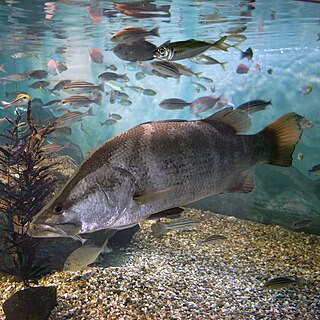
The Japanese lates, also known as the akame or Japanese barramundi, is a species of fish found in Japan. A bottom-dweller restricted to estuarine habitats and large rivers in the Pacific coastal western parts of the country, it is threatened by habitat destruction. As it is similar to the related barramundi, it was classified as the same species until 1984.

Marsupenaeus is a monotypic genus of prawn. It contains a single species, Marsupenaeus japonicus, known as the kuruma shrimp, kuruma prawn, or Japanese tiger prawn. It occurs naturally in bays and seas of the Indo-West Pacific, but has also reached the Mediterranean Sea as a Lessepsian migrant. It is one of the largest species of prawns, and is accordingly one of the most economically important species in the family.
Chuhsiungichthys is an extinct genus of ichthyodectiform ray-finned fish that lived in freshwater environments in what is now Yunnan, China, and Kyushu, Japan, during the Cretaceous. It differs from its sister genus, Mesoclupea, primarily by having a comparatively more anteriorly-placed dorsal fin.
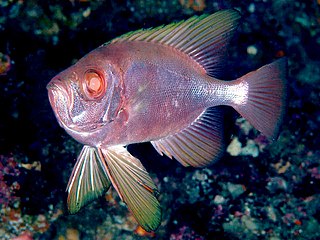
Cookeolus japonicus is a species of fish in the family Priacanthidae, the bigeyes and catalufas. It is the only extant species of Cookeolus, except for C. spinolacrymatus, an extinct Late Pliocene fish known from a fossil specimen collected in Okinawa, Japan.

Limnichthys is a genus of sandburrowers native to the Indian and Pacific oceans.

Gerres is a genus of mojarras found mostly in coastal regions from the eastern Atlantic Ocean through the Indian Ocean to the western Pacific. A single species, G. simillimus, is from the East Pacific. They mainly inhabit salt and brackish waters, but will enter fresh water. At least one species, Gerres cinereus, displays an ability akin to gyroscopic stability, allowing it to remain in a remarkably static spatial position relative to the water flowing around it.
Paedogobius kimurai is a species of goby from the subfamily Gobionellinae, and the only member of the monotypic genus Paedogobius. It is native to marine and brackish waters of inner bays in Japan, Thailand and Australia. Its English language common names include wide-gape paedomorphic goby and babyface goby. Its Japanese language common name is shirasukiba-haze.

Branchiostegus is a genus of marine ray-finned fishes, tilefishes belonging to the family Malacanthidae. They are found in the eastern Atlantic Ocean through the Indian Ocean to the western Pacific Ocean. Here they create burrows in soft substrates in the comparatively deep waters of the continental shelf and slope.

Liopropoma is a genus of marine ray-finned fish, related to the groupers and included in the subfamily Epinephelinae, part of the family Serranidae, which also includes the anthias and sea basses. They are sometimes seen in the marine aquarium trade.
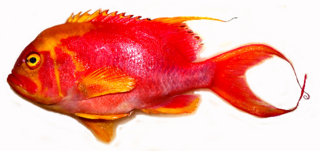
Meganthias is a genus of marine ray-finned fish from the subfamily Anthiinae, part of the family Serranidae, the groupers and sea basses. They are found in the Indo-Pacific region and the eastern Atlantic Ocean.

The spottedtail morwong is a species of marine ray-finned fish, traditionally regarded as belonging to the family Cheilodactylidae, the members of which are commonly known as morwongs. It is found in the northwest Pacific Ocean.
Inegocia japonica, the Japanese flathead, rusty flathead or smooth flathead, is a species of marine ray-finned fish belonging to the family Platycephalidae, the flatheads. It is found in the Indo-West Pacific region.

















